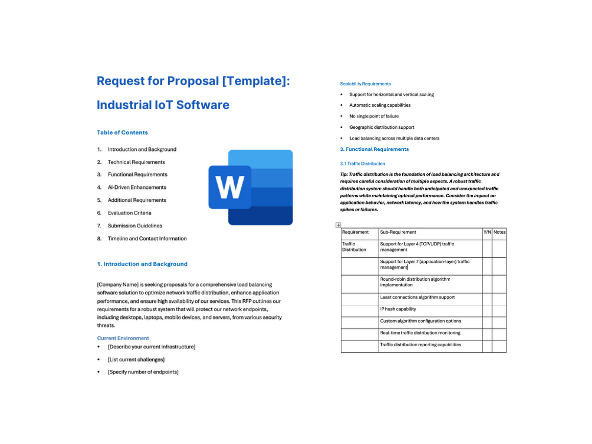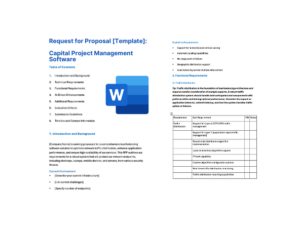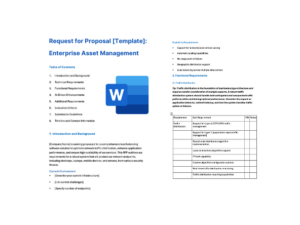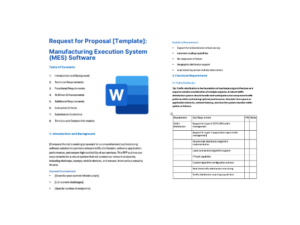Request for Proposal (RFP): Industrial IoT Software Solution
Table of Contents
- Introduction and Background
- Project Objectives
- Scope of Work
- Technical Requirements
- Functional Requirements
- AI and Machine Learning Requirements
- Implementation Requirements
- Vendor Qualifications
- Evaluation Criteria
- Submission Guidelines
- Timeline
1. Introduction and Background
Our organization is seeking proposals for a comprehensive Industrial Internet of Things (IIoT) software solution to enhance our manufacturing operations and enable Industry 4.0 capabilities. This RFP outlines our requirements for a robust system that will help optimize resource usage, improve product quality, and automate routine tasks while generating valuable operational data across our supply chain.
2. Project Objectives
- Optimize manufacturing resource usage and improve product quality through IoT-enabled monitoring and control
- Implement automated processes and intelligent workflows across operations
- Enable predictive maintenance capabilities for critical equipment
- Establish real-time monitoring and analytics for manufacturing operations
- Create a scalable foundation for future Industry 4.0 initiatives
- Unify distributed factory equipment and data
- Enhance operational intelligence and innovation
- Support human-machine collaboration initiatives
- Implement sustainable manufacturing practices
3. Scope of Work
3.1 Required Capabilities
- IoT Device Management and Synchronization
- Real-time Monitoring and Analytics
- Process Automation and Workflow Creation
- Predictive Maintenance
- System Integration
- Data Processing and Storage
- Security Implementation
- Training and Knowledge Transfer
- Digital Twin Creation and Management
- Edge Computing Implementation
- Human-Machine Interface Development
3.2 Implementation Phases
- Assessment and Planning
- Infrastructure Setup
- Software Deployment
- Integration with Existing Systems
- Testing and Validation
- Training and Documentation
- Go-Live and Support
4. Technical Requirements
4.1 IoT Device Integration
- Synchronization capabilities with IoT-enabled industrial assets
- Support for various IoT protocols and standards
- Remote device configuration and management
- Asset tracking and monitoring capabilities
4.2 Data Management
- Real-time data processing for high-volume streams
- Scalable cloud storage solutions
- Edge computing capabilities
- Data retention and archiving policies
4.3 Security Requirements
- Secure boot technology
- End-to-end encryption for data in transit and at rest
- Security monitoring and analysis tools
- Compliance with IEC 62443 and other relevant standards
- Regular security audits and updates
- Access control and authentication mechanisms
4.4 Integration Requirements
- Support for standard APIs and interfaces
- Compatibility with Asset Administration Shell standards
- Integration capabilities with:
- IoT platforms
- Manufacturing Execution Systems (MES)
- Manufacturing Intelligence Software
- Warehouse Management Systems
- Digital Twin Platforms
4.5 Infrastructure Requirements
- 5G network compatibility
- Real-Time Location Systems (RTLS) integration
- Edge computing infrastructure support
- High availability and fault tolerance
- Support for distributed assets and remote locations
- Flexible deployment options (cloud, on-premises, or hybrid)
5. Functional Requirements
5.1 IoT Device Synchronization and Management
Tip: Effective device synchronization and management is crucial for IIoT implementation success. Look for solutions that provide comprehensive control over all industrial assets while ensuring seamless integration with existing infrastructure.
| Requirement |
Sub-Requirement |
Y/N |
Notes |
| Asset Integration |
Sync with factory equipment |
|
|
|
Sync with inventory areas |
|
|
|
Sync with worker devices |
|
|
| Asset Management |
Asset tracking capabilities |
|
|
|
Device configuration tools |
|
|
|
Remote access/control features |
|
|
| Network Integration |
IoT network integration |
|
|
|
Software solution integration |
|
|
5.2 Real-time Monitoring and Analytics
Tip: Real-time monitoring capabilities should provide comprehensive visibility into all aspects of operations, with granular control and actionable insights for immediate response to changing conditions.
| Requirement |
Sub-Requirement |
Y/N |
Notes |
| Machine Monitoring |
Live performance tracking |
|
|
|
Machine health monitoring |
|
|
| Equipment Analysis |
Granular parts monitoring |
|
|
|
Connected process monitoring |
|
|
| Data Management |
Distributed asset data collection |
|
|
|
Data analysis capabilities |
|
|
| Insights Generation |
Production insights |
|
|
|
Work environment insights |
|
|
|
Equipment health insights |
|
|
5.3 Automation and Workflow Creation
Tip: Automation capabilities should be flexible and intelligent, allowing for both simple and complex workflow creation while supporting dynamic process adjustments based on real-time conditions.
| Requirement |
Sub-Requirement |
Y/N |
Notes |
| Process Automation |
Automated process flows |
|
|
|
Response flow implementation |
|
|
| Workflow Management |
Intelligent workflow creation |
|
|
|
Situation-specific workflows |
|
|
| Machine Control |
Trigger-based process adjustment |
|
|
|
Machine-to-machine signaling |
|
|
5.4 Predictive Maintenance
Tip: Predictive maintenance features should combine real-time analytics with predictive modeling to prevent failures and optimize asset performance while providing actionable improvement suggestions.
| Requirement |
Sub-Requirement |
Y/N |
Notes |
| Performance Analytics |
Real-time machine analytics |
|
|
| Maintenance Features |
Predictive maintenance tools |
|
|
|
Maintenance scheduling |
|
|
| Asset Optimization |
Proactive improvement suggestions |
|
|
|
Critical asset monitoring |
|
|
5.5 Integration Capabilities
Tip: Integration capabilities should support seamless connection with existing systems while providing flexibility for future expansions and digital transformation initiatives.
| Requirement |
Sub-Requirement |
Y/N |
Notes |
| Platform Integration |
IoT platform integration |
|
|
|
Connected worker platform integration |
|
|
| System Integration |
Manufacturing execution system integration |
|
|
|
Manufacturing intelligence software integration |
|
|
|
Warehouse management software integration |
|
|
| Digital Twin Support |
Digital twin creation |
|
|
|
Digital twin management |
|
|
5.6 Data Processing and Storage
Tip: Data processing and storage solutions should handle high-volume data efficiently while providing flexible deployment options and ensuring data accessibility across the organization.
| Requirement |
Sub-Requirement |
Y/N |
Notes |
| Real-time Processing |
High-volume data processing |
|
|
|
High-velocity data handling |
|
|
| Storage Solutions |
Scalable cloud storage |
|
|
|
Data management tools |
|
|
| Edge Computing |
Local data processing |
|
|
|
Edge device management |
|
|
5.7 Security Features
Tip: Security features should provide comprehensive protection at all levels while ensuring compliance with industry standards and supporting regular security assessments.
| Requirement |
Sub-Requirement |
Y/N |
Notes |
| Boot Security |
Secure boot technology |
|
|
| Data Security |
Data-in-transit encryption |
|
|
|
Data-at-rest encryption |
|
|
| Security Tools |
Security monitoring tools |
|
|
|
Security analysis capabilities |
|
|
| Compliance |
IEC 62443 compliance |
|
|
|
Industry-specific security standards |
|
|
5.8 Interoperability and Standards
Tip: Interoperability features should ensure seamless communication between different systems while maintaining compliance with industry standards and regulations.
| Requirement |
Sub-Requirement |
Y/N |
Notes |
| API Support |
Standard API support |
|
|
|
Interface compatibility |
|
|
| Industry 4.0 |
Asset Administration Shell compatibility |
|
|
| Compliance |
Industry regulation adherence |
|
|
|
Standards compliance |
|
|
5.9 Scalability and Performance
Tip: Scalability and performance features should support growth while maintaining system reliability and offering flexible deployment options to meet changing business needs.
| Requirement |
Sub-Requirement |
Y/N |
Notes |
| Device Management |
Large-scale device handling |
|
|
|
High data volume processing |
|
|
| System Reliability |
High availability features |
|
|
|
Fault tolerance capabilities |
|
|
| Deployment Options |
Cloud deployment support |
|
|
|
On-premises deployment |
|
|
|
Hybrid deployment capabilities |
|
|
5.10 User Interface and Experience
Tip: User interface should be intuitive and accessible while providing powerful visualization tools and supporting different user roles and access levels.
| Requirement |
Sub-Requirement |
Y/N |
Notes |
| Dashboard Features |
Intuitive dashboard tools |
|
|
|
Visualization capabilities |
|
|
| Access Control |
Role-based access management |
|
|
| Mobile Features |
Remote monitoring support |
|
|
|
Mobile management capabilities |
|
|
5.11 5G Integration
Tip: 5G integration should enable enhanced connectivity and data transfer while supporting future communication needs.
| Requirement |
Sub-Requirement |
Y/N |
Notes |
| 5G Capabilities |
Network connectivity enhancement |
|
|
|
Fast data transfer support |
|
|
5.12 Real-Time Location Systems (RTLS)
Tip: RTLS integration should provide accurate tracking capabilities for all asset types while supporting real-time location monitoring.
| Requirement |
Sub-Requirement |
Y/N |
Notes |
| Tracking Capabilities |
Asset tracking integration |
|
|
|
Equipment location monitoring |
|
|
|
Personnel tracking features |
|
|
5.13 Human-Machine Collaboration
Tip: Human-machine collaboration features should facilitate seamless interaction between workers and machines while supporting various interface types and integration with collaborative robots.
| Requirement |
Sub-Requirement |
Y/N |
Notes |
| Collaboration Features |
Worker-machine interaction support |
|
|
| Device Integration |
Wearable device interfaces |
|
|
|
Cobot integration capabilities |
|
|
5.14 Sustainability Features
Tip: Sustainability features should provide comprehensive monitoring and optimization tools for environmental impact reduction while supporting energy efficiency initiatives.
| Requirement |
Sub-Requirement |
Y/N |
Notes |
| Energy Management |
Energy consumption monitoring |
|
|
|
Energy optimization tools |
|
|
| Waste Management |
Waste reduction monitoring |
|
|
|
Optimization tools |
|
|
6. AI and Machine Learning Requirements
6.1 Predictive Analytics
Tip: Predictive analytics should leverage AI algorithms to provide comprehensive forecasting and optimization capabilities across all operational aspects.
| Requirement |
Sub-Requirement |
Y/N |
Notes |
| Equipment Management |
Failure prediction algorithms |
|
|
| Production Management |
Schedule optimization |
|
|
| Supply Chain |
Supply chain visibility enhancement |
|
|
6.2 Anomaly Detection
Tip: Anomaly detection should employ advanced machine learning models to identify and alert on data pattern irregularities across all monitored systems.
| Requirement |
Sub-Requirement |
Y/N |
Notes |
| Pattern Analysis |
ML model implementation |
|
|
|
Data pattern monitoring |
|
|
|
Irregularity identification |
|
|
6.3 Autonomous Decision-Making
Tip: Autonomous decision-making systems should provide reliable real-time decisions while maintaining appropriate human oversight and control mechanisms.
| Requirement |
Sub-Requirement |
Y/N |
Notes |
| AI Systems |
Real-time decision making |
|
|
|
Autonomous operation capability |
|
|
|
Human oversight integration |
|
|
6.4 Edge AI Capabilities
Tip: Edge AI capabilities should support distributed intelligence while optimizing resource usage and enabling real-time processing at the edge.
| Requirement |
Sub-Requirement |
Y/N |
Notes |
| Edge Processing |
Edge device AI algorithms |
|
|
| TinyML Integration |
Resource-constrained ML deployment |
|
|
| Visual Inspection |
Edge-based computer vision |
|
|
|
Quality control capabilities |
|
|
6.5 Natural Language Processing (NLP)
Tip: NLP features should provide intuitive interaction methods while supporting automated documentation and maintenance assistance.
| Requirement |
Sub-Requirement |
Y/N |
Notes |
| Support Systems |
AI-powered maintenance chatbots |
|
|
| Interface Control |
Voice-controlled interfaces |
|
|
| Documentation |
Automated document generation |
|
|
|
Documentation analysis |
|
|
6.6 Generative AI for Industrial Design
Tip: Generative AI features should support optimization across design and process aspects while enabling automated code generation for control systems.
| Requirement |
Sub-Requirement |
Y/N |
Notes |
| Design Optimization |
Product design AI algorithms |
|
|
|
Component design optimization |
|
|
| Process Management |
Process optimization suggestions |
|
|
| Code Generation |
Industrial control software automation |
|
|
6.7 AI-Driven Digital Twins
Tip: Digital twin capabilities should leverage AI for accurate modeling and optimization while supporting complex scenario analysis.
| Requirement |
Sub-Requirement |
Y/N |
Notes |
| Modeling |
Predictive digital twin modeling |
|
|
| Optimization |
Real-time model optimization |
|
|
| Analysis |
Complex scenario analysis |
|
|
| Risk Management |
Decision-making support |
|
|
6.8 Hyper Data Analysis
Tip: Hyper data analysis capabilities should support diverse data type processing while ensuring comprehensive analysis capabilities.
| Requirement |
Sub-Requirement |
Y/N |
Notes |
| Data Processing |
Time-series data analysis |
|
|
|
Text data analysis |
|
|
|
Visual data analysis |
|
|
6.9 Autonomous Optimization
Tip: Autonomous optimization systems should provide comprehensive optimization across all operational aspects while ensuring efficient resource utilization.
| Requirement |
Sub-Requirement |
Y/N |
Notes |
| Schedule Optimization |
Production schedule AI |
|
|
| Resource Management |
Resource allocation optimization |
|
|
| Energy Optimization |
Energy usage optimization |
|
|
7. Implementation Requirements
7.1 Assessment and Planning
- Current process assessment
- Improvement area identification
- Hardware requirements analysis
- Network infrastructure evaluation
- Data management strategy development
- Security assessment
7.2 Infrastructure Setup
- IoT device installation
- Network configuration
- Sensor deployment
- Edge computing setup
- Security implementation
- Integration framework establishment
7.3 Training and Support
- Comprehensive staff training program
- Documentation requirements
- Ongoing support services
- Knowledge transfer plan
- User adoption strategy
- Technical support requirements
8. Vendor Qualifications
Required qualifications:
- Proven experience in IIoT software implementation
- Industry-specific expertise and certifications
- Financial stability documentation
- Reference implementations in similar industries
- Support and maintenance capabilities
- Training and documentation resources
- Innovation track record
- R&D capabilities
- Partnership ecosystem details
9. Evaluation Criteria
Proposals will be evaluated based on:
- Technical capability and feature completeness (25%)
- Integration capabilities and scalability (20%)
- Security and compliance features (15%)
- Implementation methodology and timeline (15%)
- Cost and ROI projections (10%)
- Vendor experience and references (10%)
- Innovation and future roadmap (5%)
10. Submission Guidelines
Proposals must include:
- Detailed solution description
- Technical specifications and architecture
- Implementation plan and timeline
- Training and support plan
- Pricing structure including:
- Licensing costs
- Implementation costs
- Training costs
- Ongoing support costs
- Client references
- Company profile and qualifications
- Innovation roadmap
- Risk management approach
- ROI analysis
11. Timeline
- RFP Release Date: [Date]
- Questions Deadline: [Date]
- Proposal Due Date: [Date]
- Vendor Presentations: [Date Range]
- Vendor Selection: [Date]
- Project Kickoff: [Date]
Contact Information: Name: Title: Email: Phone:



